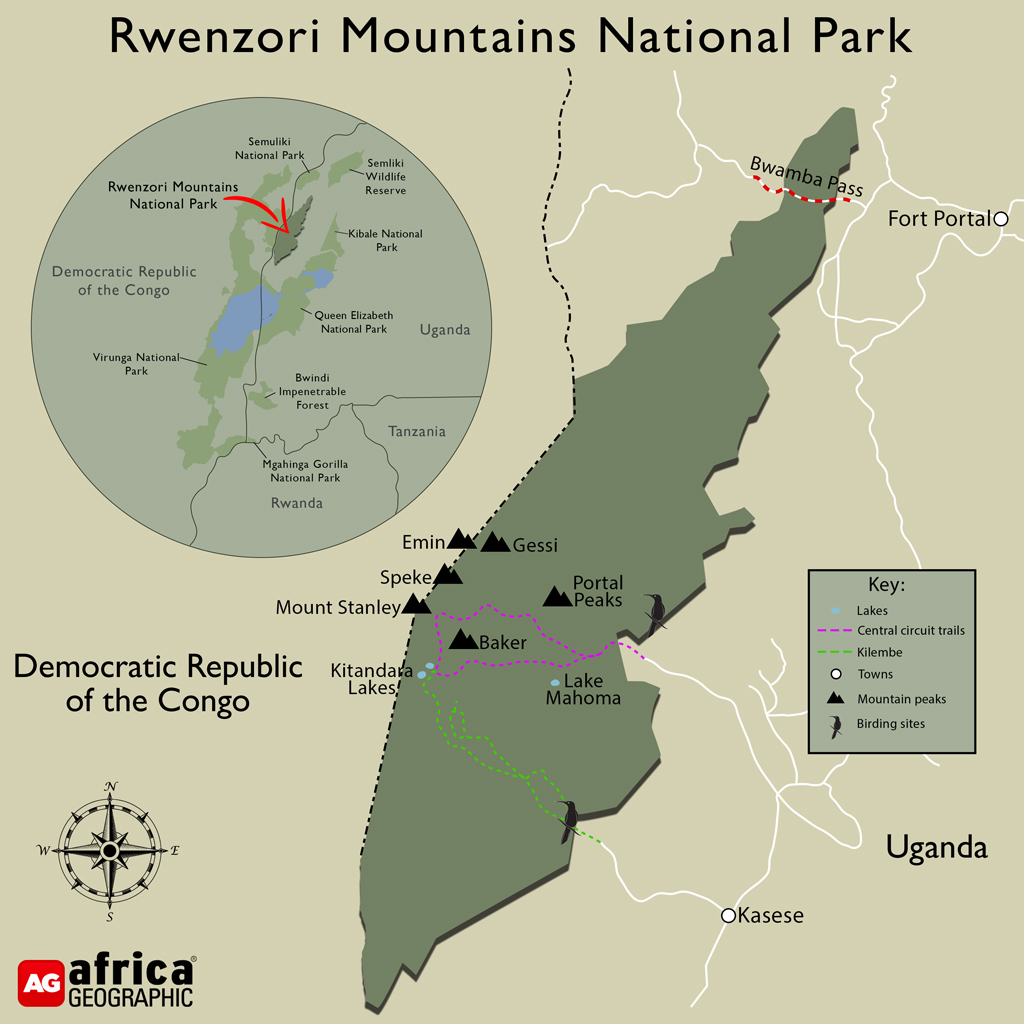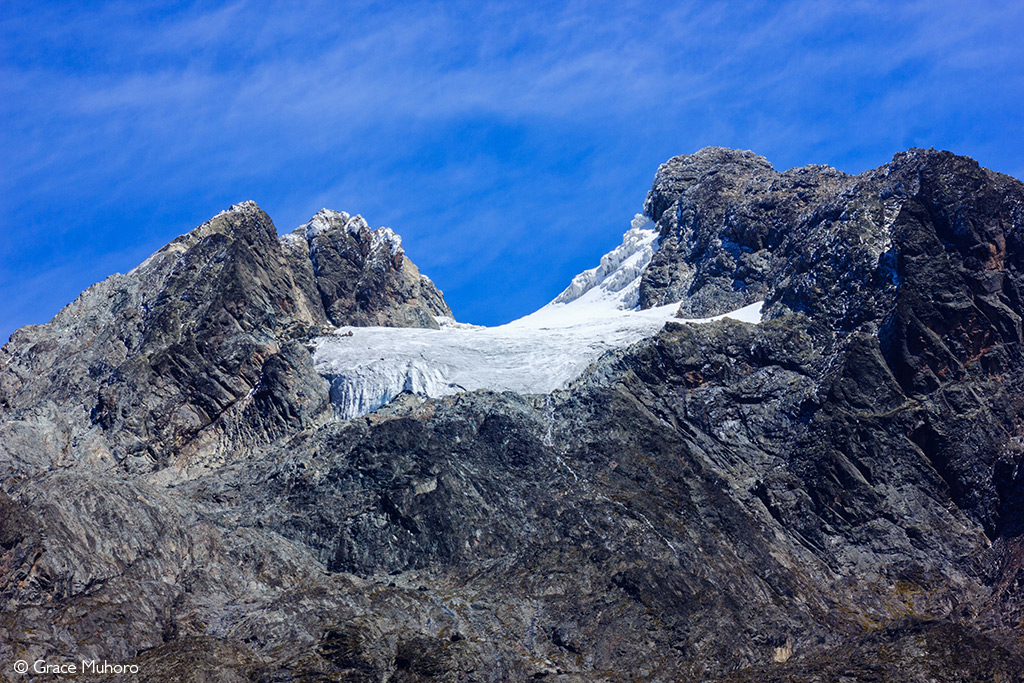
Alpine wonderland beyond the clouds


Lying just 33 kilometres north of the equator, snug in the heart of the African continent, a world of mystery and unparalleled beauty awaits the adventurous – the Rwenzori Mountains. Rising majestically along the border between Uganda and the Democratic Republic of the Congo, these enigmatic peaks evoke a sense of wonder and intrigue to all who visit – providing for an African safari like no other.
The landscape of the Rwenzoris is a dramatic blend of rugged peaks, deep valleys, and cascading waterfalls. Towering above the surrounding plains, the snow-capped mountains create a breathtaking panorama. Glacial lakes shimmer amidst the lush vegetation, and the thundering waters of the Mubuku and Bujuku Rivers add to the park’s pristine beauty. The diverse topography of the region and its location in the tropics offers a seldom-seen diversity of ecosystems, from bamboo forests to alpine meadows and moss-draped valleys.

Of rainmakers and mighty rivers
Recognised for its unique biodiversity and the value of water flowing from its mountainsides, the Rwenzori Mountains National Park was established in 1991. In 1994, UNESCO afforded it World Heritage Site status, and in 2008, it was named a Ramsar site for its value in the protection of wetlands. The park now conserves almost 1,000km² of this unique and vulnerable region with its five distinct vegetation zones and unprecedented levels of endemic species.
The Rwenzori Mountain region has been home to many diverse people and societies for millennia. All recognised the value of the water flowing from the peaks and held them sacred. The Bakonzo people even named the mountains “rainmaker”, a fitting name for what is one of Africa’s most essential water sources.

Ptolemy, the Greek-Egyptian astronomer, mathematician, and geographer, incorrectly identified the Rwenzoris as the source of the Nile River, giving the range its charming moniker “Montes Lunae” or the “Mountains of the Moon”. Not until much later was the true source discovered at Lake Victoria in Uganda.
Since becoming known outside of Africa, the region has captivated the imaginations of explorers, adventurers and scientists worldwide, sparking expeditions to try and unravel the mysteries and secrets of this primordial wonder.


Moody rainforests and misty Rwenzori peaks
The Rwenzori massif stretches for roughly 120 kilometres along the western leg of the Albertine Rift, its jagged ridges, glacial valleys, and lush vegetation creating an otherworldly landscape that beckons the adventurous. These majestic giants are adorned with a crown of ever-present snow and ice, defying their equatorial location and creating a unique alpine environment. The unique combination of high altitude, equatorial location, and calm, wet climate in the Rwenzori Mountains has resulted in distinct ecosystems and rich biodiversity. It is not only the imposing height and alpine beauty that define the Mountains of the Moon. Its exceptional biodiversity and remarkable flora characterise the region. Within its diverse ecological zones, from the lowland rainforests to the moss-draped afro-alpine zone, one can discover a wealth of endemic plant species, colourful birdlife, and elusive wildlife.
The central mountain massif, Mount Stanley (also known as Mount Ngaliema), comprises three 5,000m peaks, of which Margherita is the tallest at 5,109m above sea level. This is the third highest peak in Africa after Kilimanjaro and Mount Kenya, but is perhaps the most difficult to summit because of the very rugged nature of the terrain there.

Trekking the Rwenzori grand trails
The Rwenzori Mountains National Park offers many attractions catering to nature enthusiasts and adventure seekers, making for a truly unique African safari experience. The park’s undoubted highlights are the Rwenzori Mountain trekking experiences available. Multi-day hikes, ranging from moderate to strenuous, allow visitors to immerse themselves in the grandeur of the mountains. The most popular trekking route is the Kilembe Trail, which allows adventurers to explore the lower slopes of the mountains and witness breathtaking views of the surrounding landscape without the exhilarating challenge of tackling the higher peaks.
If time is a challenge, a day trip with a trained and knowledgeable guide will take you along trails offering insights into the region’s unique ecology, while pointing out endemic plant species, identifying bird calls and revealing the cultural charm of the area. Participating in cultural activities, such as traditional dances, storytelling sessions, and visits to local villages, will help you gain a deeper appreciation for the region’s heritage while contributing to the livelihoods of the people who protect this environment.


Rwenzori forest specials
A visit to this region will enthral and richly reward you with sightings and experiences beyond your expectations. Your trek up these “rainmaker mountains” will take you gradually through five distinct vegetation zones, from grassland to the surreal afro-alpine landscape and on to equatorial glaciers. This diversity of habitats is rewarding but naturally yields “specials” found nowhere else. Regardless of your passion, you’ll find yourself marvelling at far more than you thought you might have should you embark on a trip to the Rwenzoris for your next African safari.
The early stages of a trek introduces visitor to the rustic lowland surroundings of coffee, vanilla and banana plantations. These soon give way at around 2,500m to shady and often misty montane forests with moss-covered trees, closed canopies, waterfalls and streams.

Here, you will do well to scan for some of the elusive forest specials the park is known for. If you are quiet and lucky, you may catch a glimpse of the Rwenzori red duiker on the forest floor. At the same time, up in the canopy, Rwenzori colobus and blue monkeys and an intriguing diversity of bird specials await. For the sharp-eyed, hiding in plain sight is the prehistoric and somewhat comical-looking Rwenzori three-horned chameleon.
The park boasts seventeen of the twenty-four Albertine Rift endemic bird species, but they will take hard work and perhaps a little luck to find. Keep an eye out for the Rwenzori turaco, handsome francolin, strange weaver, Rwenzori nightjar, barred long-tailed cuckoo, Cassin’s hawk eagle, Shelley’s crimsonwing and purple-breasted, blue-headed and Rwenzori double-collared sunbirds.
Hiring a good bird guide will help you “grab” these species, which can be frustratingly elusive. Bring a good pair of binoculars, as the low-light forest viewing conditions can make viewing difficult.
At around 3,000m, trekkers enter an eerie and dark zone of giant bamboo grasses up to 30 metres tall, which will obscure the sky as if nature is covering one’s eyes for the surprise to come. Soon, a heather and moor wonderland is revealed as the equatorial peaks appear above.

The real wonders of the Rwenzoris start above 4,000m, where botanical marvels, which evolved in isolation over millions of years, can be found. This is the afro-alpine zone – perhaps the most surreal part of this mountain world. Shrouded in mountain mists and inaccessible due to the challenging terrain, the area has been a refuge for plant life undergoing perilous evolutionary journeys. This isolation has allowed plants to evolve uniquely, adapting to the extreme conditions and carving out their niche in this montane ecosystem. The remarkable giants of the Rwenzori Mountains are a testament to the power of adaptation and the extraordinary wonders nature can create.
Enchanting giant lobelias (Lobelia gibberoa) stand tall, like sentinels, along the rugged slopes. These are among the most iconic plant species of the Rwenzori Mountains, reaching staggering heights of up to 10 metres, making them true botanical giants. Sharing their lofty habitat are giant groundsels (Dendrosenecio adnivalis), another botanical wonder of the Rwenzori Mountains. With their woody stems and tufts of silver-grey leaves, they seem to belong to a different era altogether. The groundsels bloom with clusters of bright yellow flowers that attract a myriad of insects, adding life to this surreal environment.

Explore and Stay
 Check out our selection of walking safari options for your next African safari. We have ready-made safaris to choose from – or ask us to build one just for you.
Check out our selection of walking safari options for your next African safari. We have ready-made safaris to choose from – or ask us to build one just for you.
Exploring the Rwenzori Mountains National Park is a thrilling adventure with a range of accommodation options to suit your preference, from comfortable lodges to campsites. The nearby town of Kasese provides a convenient base for trekkers, offering hotels and guesthouses for those seeking a more urban experience.
Staying in the park or its vicinity allows visitors to savour the tranquillity of the mountains and embrace the soul-stirring beauty of this unique destination. Nyakalengija Park headquarters and campsite is an excellent place to begin your trip. Register at the park office, obtain the necessary permits, and meet your experienced local guides and porters who will accompany you throughout your journey.
Kilembe Base Camp offers accommodations for hikers and provides basic facilities while also being a convenient starting point for that hiking route.

Bujuku Valley is a picturesque area renowned for its stunning scenery. Visitors can traverse this valley, crossing fast-flowing rivers and observing mesmerising waterfalls along the way. The challenging Bujuku Peak hike offers panoramic views of the mountains and valleys.
For those seeking a shorter trek, the Mahoma Trail is a popular option. This trail takes visitors up through pristine bamboo forests, offering glimpses of diverse bird species and the chance to see the elusive Rwenzori turaco.
The Rwenzori Mountains National Park is an enchanting world where nature’s wonders are magnificently displayed. From the towering peaks to the astonishing alpine flora, every facet of this extraordinary landscape beckons travellers to embark on a remarkable life-altering journey. For those who visit, the Rwenzoris will etch themselves on the soul.
Further Reading
Here’s our list of Africa’s must-visit mountain kingdoms – discover their magnitude, scenery and the creatures that call them home
To comment on this story: Login (or sign up) to our app here - it's a troll-free safe place 🙂.![]()




